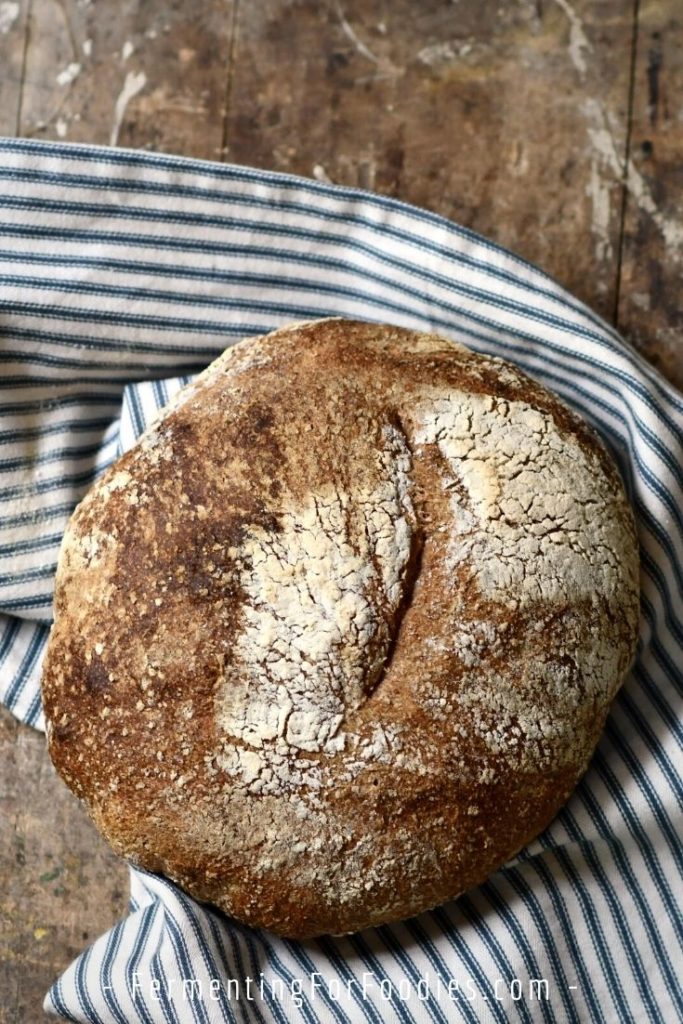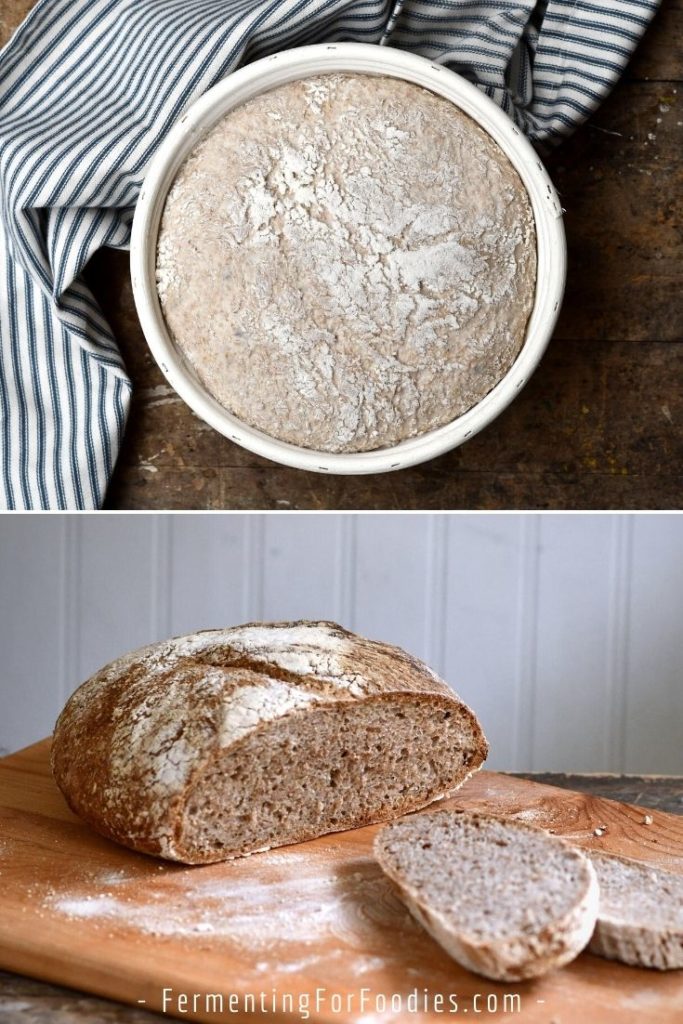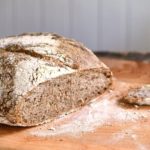Want to make 100% whole grain sourdough bread? This recipe allows you to experiment with your favorite whole grain flours to create a rustic and delicious sourdough loaf!

Whole grain sourdough bread is rich, dense, and chewy. It has a full-bodied flavor that is influenced by the type of flour, cooking temperature, and the strains of sourdough yeast and bacteria.
So let go of the idea that 100% whole grain sourdough bread is just about the good-for-you-protein and fiber, and embrace it as something that deserves its own recognition. A bread that is meant to be noticed, tasted, and enjoyed!
Experiment with different grains!
This recipe will work for any whole grain, gluten-containing flour. However, the flavor and density of the bread will change depending on the type of flour you use.
The flour will also impact the water to flour ratio. That’s why I don’t recommend this recipe for anyone wanting to make a rustic white bread loaf. For a mostly white flour loaf, check out my recipe for pain de campagne (French country loaf) instead.
We have tested this recipe with dark rye, light rye, whole wheat, spelt, and red fife.
Here’s what to expect from each of these types of flour:
- Dark rye is a heavy, low gluten flour. It results in a dense, moist loaf and may require a bit of extra flour.
- Light rye is also low in gluten, however, the bran and germ have been removed so the bread will be lighter. To make a traditional caraway rye-flavored loaf, add 2-3 tablespoons of caraway.
- Other low-gluten flours include barley, Kamut, einkorn, and emmer. The recipe was designed with a lower gluten flour, so it shouldn’t require any adjustments.
- Whole wheat, spelt, and red fife are higher gluten flours. They may require a little less flour.
- Flour blends can include a mix of low and high gluten flours. They are a great way to combine the flavor of ancient grains with the loft of wheat. Feel free to use up to a 50/50 mix of whole grain and white flour.
Do you have a favorite flour blend? Share in the comments section!

100% Whole Grain Sourdough Bread
This 100% whole grain sourdough bread is rich and delicious. It is perfect sliced fresh with butter or toasted for breakfast. It can be made with rye, barley, spelt, or whole wheat. See the section above for more details on each of these flours.
- Prep Time: 30 minutes
- Cook Time: 50 minutes
- Total Time: 1 hour 20 minutes
- Yield: 2 loaves 1x
- Category: Bread
- Method: Sourdough
- Cuisine: Eastern European
- Diet: Vegan
Ingredients
- 7 cups (31 oz) whole grain flour (see section above for details)
- 3 cups (24 oz) warm water
- 1 cup (7 1/4 oz) sourdough starter
- 1 Tbsp salt
- 1/2 tsp instant yeast (optional, to improve the rise)
Instructions
- Warm the water to approx. 32-35 C / 90-95 F, and mix with the flour. Leave the flour to hydrate for 15-30 minutes.
- Using the pincer method, mix in the sourdough starter, salt, and yeast. The dough should be stiff but not dry. If needed add a bit more water or flour. The hydration ratio will change depending on the type of flour you’re using.
- Allow to rise in a warm location until doubled in volume (about 5 hours). Use the dough folding procedure 3-4 times during this rise.
- Place the dough on a well-floured surface and cut into 2 equal pieces. Gently shape the dough into a ball, using flour, as needed, but avoid kneading. You want to keep the air bubbles.
- Place the dough balls in floured bowls or baskets, then place them in an air-tight container and leave them in the refrigerator for at least 4 hours or up to 24 hours. (We use one banneton and one mixing bowl lined with a floured tea towel. Then we put dinner plates on top of them).
- When ready to bake, preheat oven to 500 F (250 C). I recommend baking in a cast iron Dutch oven or a metal loaf pan as free-form baking will result in a flat loaf of bread. See notes for details on each of these methods.
- Bake for 40 to 55 minutes, until the loaf sounds hollow when tapped on the bottom. Cool on a rack before slicing.
Notes
- This recipe requires an active sourdough starter. I recommend making your own rather than buying one. Rye is especially good at catching a sourdough culture. The extra yeast isn’t necessary if you have a very healthy sourdough starter, though it does give the loaf a second boost.
- When baking in a loaf pan, 45 minutes will be sufficient.
- To bake in a cast iron Dutch oven, place it in the oven to preheat so it is hot when you put your loaf in. Bake the loaf for 30 minutes with the lid on. Remove the lid, and bake for another 20 minutes, until done.
Nutrition
- Serving Size: 1 large slice
- Calories: 73
- Sugar: 0.2g
- Sodium: 175mg
- Fat: 0.6g
- Saturated Fat: 0.1g
- Carbohydrates: 15.4g
- Fiber: 5.1g
- Protein: 3.2g
- Cholesterol: 0mg



I wonder if I’m getting the quantities right Emillie – for the initial feed, it says 1 1/4 oz or 5 Tbsp, but when I weigh 1 1/4 ounce it is much less than 5 Tbsp. I end up with a very thick starter once I’ve mixed in the 5 oz water and 6 oz flour with the starter – it’s actually quite stiff. Is that right?
Actually, I’m GF… so I consulted with my husband who regularly makes rye (and created this recipe). He says it should be stiff like firm cookie dough… however, all flours are different, so you may need to add more water depending on your whole grain flour. For example, a dark rye would need less water than a white rye.
He says that he does it a bit by feel. The next time he makes this I will take photos.
I’ve just rewritten the recipe to skip the initial feed of the starter by using a much larger amount of sourdough starter. As a result the ratio of flour to water will depend on how wet your starter is.
I have a starter that worked great with whole wheat flour or bread flour but I fed it with barley flour and it isn’t rising at all.. any thoughts? Not sure what to do..
Unfortunately, sourdough starters don’t like to change types of flour. I think each flour has their own type of culture. However, if you keep feeding the barley it should pick up in a few days. There won’t be as many bubbles as the wheat starter because of the lower gluten and less structure. However, it will smell sour and have some bubbles. Good luck!
Just wanted to share that I made this recipe recently in 2 loaf tins, to have something that’s easier to use for sandwiches. It worked really well. I put the dough in the loaf tins and then in the refrigerator overnight. In the morning, I took them out a couple of hours before backing. I heated the oven to 425 and then turned it down to 375 when I put them in. Baked for about 45 minutes, and they were perfect. Thanks for the recipe!
Thanks for sharing! Hope you and your family are doing well with the current social distancing. Be well, Emillie
Thanks, Emillie! We’re doing fine, and very thankful for all of the things that make it possible to stay at home and support the fight. Hope you and your family are doing well too!
Do you really bake the bread @ 500’F? Or do you start at that and then turn it down to say 350’F? I found that the bread burned @ 500’F so now I start at that, heat the Dutch oven at that temperature then reduce the heat to 350’F to bake the bread.
The 500F is tricky as many ovens don’t heat as hot at that temperature. It sounds like you have a really good hot oven. Glad you found a way to make it work. Regardless, I will play with the temperature the next time I bake this bread (about once a month) and see if I can find a lower temperature that might work for everyone. Thanks!
Hi, I made this last weekend with whole grain spelt flour using also your recipe for the kefir sourdough starter. I added some lineseed and sunflower seeds and it turned out great! I only wish the crust was a bit more crunchy but I dont have a dutch oven and I think my dough might have been a bit too wet also. But definitely want to give it another try ! Does anyone else have experience with putting other things in, maybe walnuts might be nice as well? Or some seasoning like fennel or anis?
My French bread recipe includes some ideas for additions to this loaf. https://www.fermentingforfoodies.com/french-sourdough-bread/ My husband has only tried adding caraway to this recipe for a caraway rye bread. Enjoy!
What is the pincer method?
You can find details in this post on general sourdough techniques: https://www.fermentingforfoodies.com/basic-sourdough-bread-technique/ Enjoy!
Made this with stone ground whole wheat only and added a little molasses, and did end up adding a little water as suggested in the notes. I only made one loaf, so that I could tell if I wanted to change anything. I also turned down my oven (to 450 degrees) when I put the bread in.
It came out beautifully! Perfect crust and crumb. I will add more molasses next time, and maybe try it in loaf pans.
The molasses is a good addition. I’ll try that sometime soon. Thanks for the suggestion!
Hi I have made this recipe twice now. Both times turned out great. I followed the recipe pretty much exactly. I have a 100% hydration whole wheat starter and then used a combo of whole wheat and sprouted spelt for the flour. I used regular loaf tins and baked at 500 degF for 30 min and then covered with foil for about 15 min at the end so the bread wouldn’t burn. Worked fine. I don’t think my oven gets as hot as says. I used the exact weights as listed. Question though…I did not do the refrigeration step either time. What does that step do?
Glad the recipe worked for you! The refrigeration is not necessary. However, it helps with flavour development. Since the cold temperature slows down the yeast, it gives the bacterial cultures in sourdough a chance to multiply.
2nd time I have tried this recipe. and once again, 100% Dark rye does not stretch at all so the folding is impossible.. The technique that is referenced is using much higher gluten content flour. It would be nice to see what yours actually looks like with 100% Rye because although I really like the taste I usually throw away these instuctions by the time I get to the pinching in of the starter.
I chatted with my husband (the bread baker) and he agrees. You can’t pull the loaf with 100% rye. Probably the issue is that we tried to do too much with one recipe. It’s a good wholegrain bread… but not for really low gluten flour. I’ll pull out the rye bread for a separate recipe sometime this winter. Thanks!
Hi Emilie. I was excited to find this recipe as I wanted to try a barley sourdough bread. But i couldn’t stretch cause the barley is a low gluten flour. I followed all the other instructions and baked it but it hardly had any rise. Any tips or tricks that I could use to experiment with this type of flour?
Hi Rachel, Barley is very low gluten. I’m guessing you used 100% barley? We’ve done 100% rye, and it is similarly dense (think of those traditional German loaves). If you would like more loft, I have few recommendations: 1. Use a mix of wheat and barley. 2. Make flat baguette-style loaves, which should rise more easily (without all the weight of a boule). 3. Try one of my GF breads, which uses other binders to replace the gluten. This one is my favorite: https://www.fermentingforfoodies.com/gluten-free-and-vegan-sourdough-bread/ I haven’t tried it with a low-gluten flour, but it’s pretty much my go-to gluten-free loaf! I imagine it would work even better with barley. Cheers, Emillie
I am beyond excited! I live in Zimbabwe and use a very unrefined, low gluten wholewheat flour to make bread and for years have used commercial dry yeast. I have never had a bread that looks as amazing and tastes as amazing as this. I followed the recipe completely, failed at my first attempt to catch a starter because my flour just didn’t play ball. Switched to a conventional white all purpose flour for the starter and used that to make the bread with my usual flour. Thanks for blowing my mind, I thought bread like this was not possible here!
Hurrah! I’m so glad this recipe works with your unrefined flour! Thanks for sharing. 🙂
Yay, this is the method I’ve been using for years! Best way ever, thanks to Jim Lahey, Ken Forkish and Peter Reinhart (my sourdough heroes before Emillie).
My 100% whole grain bread comes out really nice as long as I use at least half spelt. The rest is a mixture of all kinds of grains and lately even smaller amounts of chia, gram, hemp, banana flour. You name it.
My starter is always 100% rye. Being German I like a denser bread;-)
Cheers
Sigi
Nice! My husband has gotten into really dense rye bread lately. He’s been making a dense Northern European style bread with sunflower seeds lately. Might write it up as a recipe sometime soon. 🙂 Glad you enjoy it!